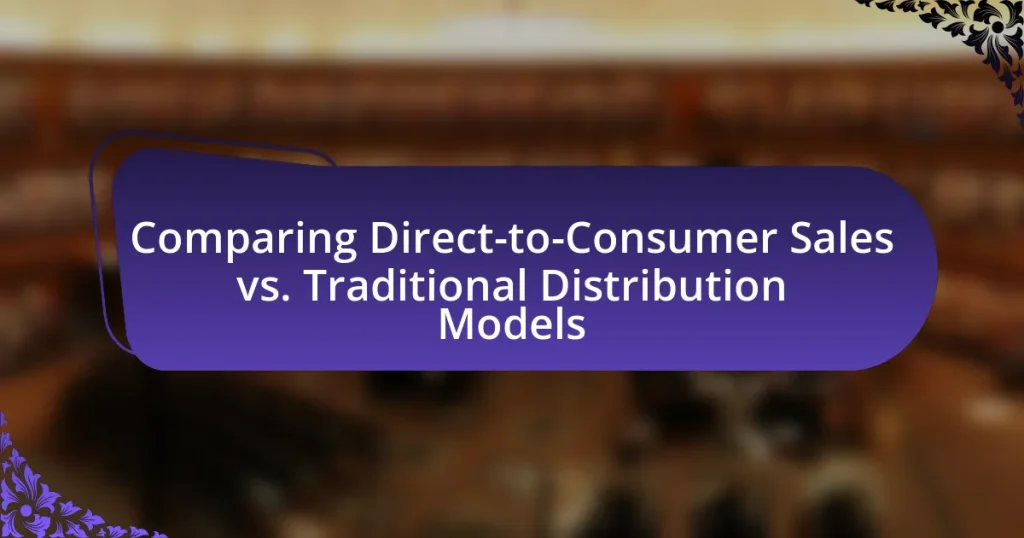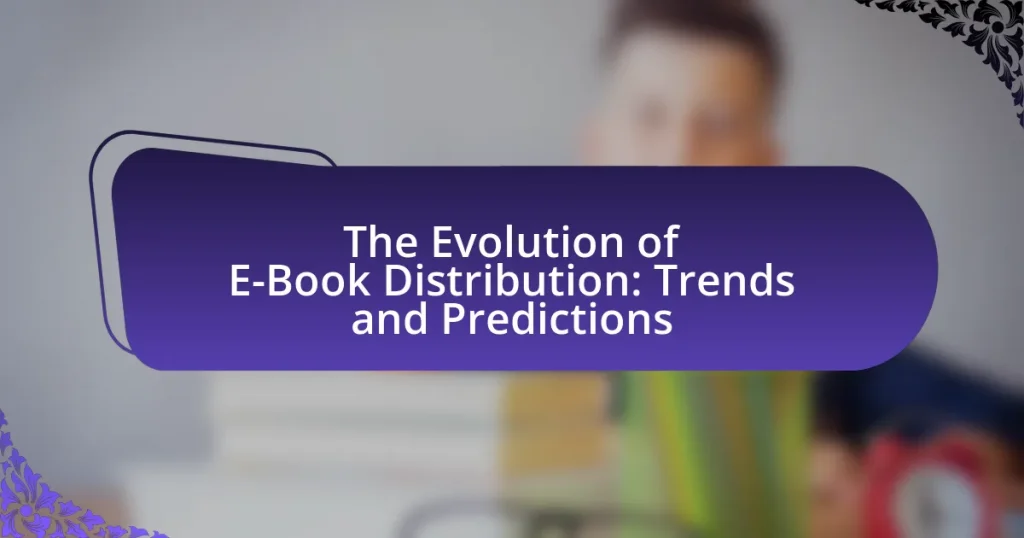Traditional bookstores are essential components of modern distribution strategies, serving as community hubs that enhance consumer access to literature and foster local engagement. They provide curated selections of titles that reflect regional interests, immediate product availability, and personalized customer service, which are often preferred over online shopping experiences. The article explores the evolving role of traditional bookstores in the current book distribution landscape, their interactions with online retailers, the challenges they face, and the strategies they can adopt to thrive amidst competition. Additionally, it highlights the significance of community engagement, partnerships with publishers, and innovative marketing techniques in reinforcing the relevance of traditional bookstores in the digital age.
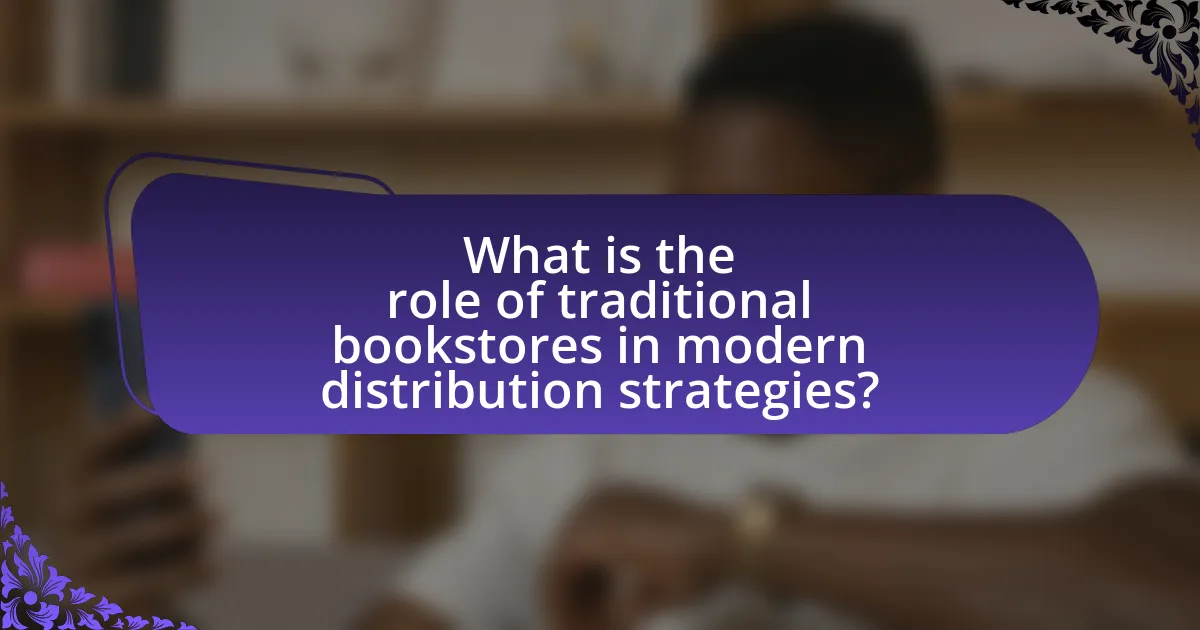
What is the role of traditional bookstores in modern distribution strategies?
Traditional bookstores play a crucial role in modern distribution strategies by serving as vital points of access for consumers and fostering community engagement. They provide a curated selection of titles that often reflect local interests and preferences, which enhances the shopping experience compared to online platforms. Additionally, traditional bookstores facilitate immediate product availability, allowing customers to purchase books on-site without waiting for shipping, thus meeting the demand for instant gratification. According to a 2021 survey by the American Booksellers Association, 75% of consumers reported that they prefer shopping at independent bookstores for their personalized service and community atmosphere, highlighting their importance in the distribution landscape.
How do traditional bookstores fit into the current book distribution landscape?
Traditional bookstores play a crucial role in the current book distribution landscape by serving as community hubs that foster reader engagement and provide personalized customer service. They complement online retailers by offering unique in-store experiences, such as author events and book clubs, which cannot be replicated digitally. According to the American Booksellers Association, independent bookstores have seen a resurgence, with a 30% increase in the number of independent bookstores in the U.S. from 2009 to 2019, indicating their enduring relevance. This growth highlights their ability to adapt to changing consumer preferences while maintaining a vital connection to local communities.
What are the key functions of traditional bookstores in distribution?
Traditional bookstores play a crucial role in the distribution of books by serving as physical retail locations that facilitate direct access to a wide range of titles for consumers. They provide a curated selection of books, enabling customers to discover new authors and genres, which is essential for promoting sales and supporting publishers. Additionally, traditional bookstores often engage in community events, such as author signings and book clubs, which enhance customer loyalty and drive foot traffic, further contributing to the distribution network. According to the American Booksellers Association, independent bookstores accounted for approximately 20% of the U.S. book market in 2020, highlighting their significant impact on book distribution.
How do traditional bookstores interact with online retailers?
Traditional bookstores interact with online retailers primarily through partnerships and competition. Many traditional bookstores have established online sales platforms to complement their physical stores, allowing them to reach a broader audience. For instance, some independent bookstores utilize online marketplaces like Amazon or Bookshop.org to sell their inventory, thereby increasing their visibility and sales potential. Additionally, traditional bookstores often engage in price matching or promotional strategies to compete with online retailers, ensuring they remain relevant in a digital marketplace. This interaction is crucial as it helps traditional bookstores adapt to changing consumer behaviors, with a significant percentage of book sales now occurring online, highlighting the need for a hybrid approach in modern distribution strategies.
Why are traditional bookstores still relevant in the digital age?
Traditional bookstores remain relevant in the digital age due to their unique ability to provide a tactile and immersive experience that online platforms cannot replicate. This physical interaction with books allows customers to browse, feel, and engage with the material, fostering a deeper connection to literature. Additionally, traditional bookstores often serve as community hubs, hosting events, author signings, and book clubs that encourage social interaction and cultural engagement. According to a 2021 report by the American Booksellers Association, independent bookstores saw a 30% increase in sales during the pandemic, highlighting their resilience and continued importance in the book distribution landscape.
What unique experiences do traditional bookstores offer to customers?
Traditional bookstores offer customers unique experiences such as personalized recommendations, community events, and a tactile browsing environment. These experiences foster a deeper connection between readers and books, enhancing customer engagement. For instance, personalized recommendations from knowledgeable staff can lead to discovering new authors or genres, which is often more effective than algorithm-driven suggestions found online. Additionally, many traditional bookstores host events like author signings, book clubs, and readings, creating a sense of community and belonging among book lovers. The physical space of a bookstore allows customers to browse and interact with books in a way that digital platforms cannot replicate, providing a sensory experience that includes the smell of books and the ambiance of the store.
How do traditional bookstores contribute to local communities?
Traditional bookstores contribute to local communities by serving as cultural hubs that foster social interaction and promote literacy. These establishments often host events such as book readings, author signings, and community discussions, which encourage community engagement and strengthen local ties. According to a study by the American Booksellers Association, independent bookstores generate an estimated 27% more local economic impact per dollar spent compared to chain stores, highlighting their role in supporting local economies. Additionally, traditional bookstores often curate selections that reflect the interests and needs of their communities, further enhancing their relevance and connection to local residents.
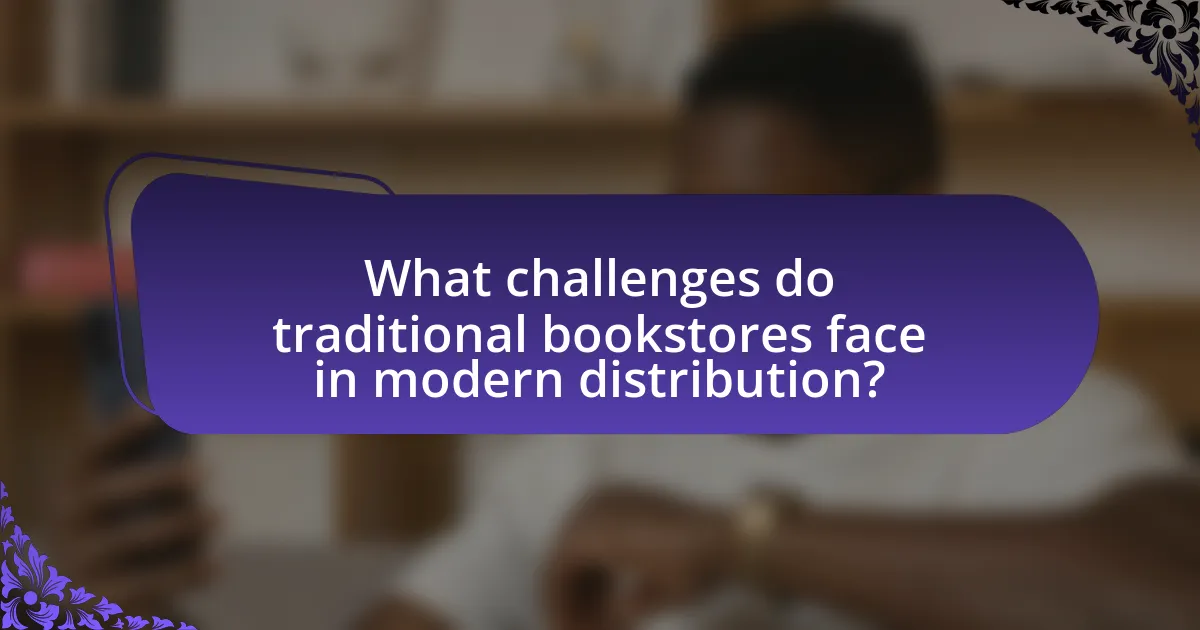
What challenges do traditional bookstores face in modern distribution?
Traditional bookstores face significant challenges in modern distribution, primarily due to competition from online retailers and changing consumer preferences. The rise of e-commerce giants like Amazon has led to a decline in foot traffic and sales for physical bookstores, as consumers increasingly opt for the convenience of online shopping. According to a 2021 report by the American Booksellers Association, independent bookstores saw a 30% increase in sales during the pandemic, but they still struggle to compete with the vast inventory and lower prices offered by online platforms. Additionally, traditional bookstores often have limited access to distribution networks, making it difficult to obtain popular titles quickly and efficiently. This limitation can hinder their ability to meet customer demand, further impacting their sales and market presence.
How has the rise of e-commerce impacted traditional bookstores?
The rise of e-commerce has significantly diminished the market share and profitability of traditional bookstores. As online retailers like Amazon offer vast selections, competitive pricing, and convenient delivery options, many consumers prefer shopping online over visiting physical stores. According to a 2021 report by the American Booksellers Association, independent bookstores saw a decline in sales by approximately 30% during the pandemic, largely attributed to the shift towards online purchasing. This trend has forced traditional bookstores to adapt by enhancing their online presence, diversifying product offerings, and creating unique in-store experiences to attract customers.
What are the financial challenges faced by traditional bookstores?
Traditional bookstores face significant financial challenges, primarily due to competition from online retailers, high operational costs, and changing consumer preferences. The rise of e-commerce giants like Amazon has led to a substantial decline in foot traffic and sales for brick-and-mortar stores, with a 2019 report indicating that independent bookstores saw a 30% drop in sales over the previous decade. Additionally, traditional bookstores incur high overhead costs, including rent, utilities, and staffing, which can be difficult to sustain in a market with shrinking profit margins. Furthermore, the shift towards digital reading formats has altered consumer buying habits, with e-books and audiobooks gaining popularity, further impacting the sales of physical books in traditional stores.
How do traditional bookstores compete with larger retail chains?
Traditional bookstores compete with larger retail chains by emphasizing personalized customer service, curated selections, and community engagement. These independent bookstores often foster a unique shopping experience that larger chains cannot replicate, such as hosting author events, book clubs, and local art displays. According to a 2019 report by the American Booksellers Association, independent bookstores saw a 35% increase in sales over the previous decade, demonstrating their ability to thrive despite competition from larger retailers. This success is attributed to their focus on building relationships with customers and creating a sense of community, which enhances customer loyalty and drives repeat business.
What strategies can traditional bookstores adopt to thrive?
Traditional bookstores can thrive by diversifying their offerings and enhancing customer experience. By incorporating events such as author signings, book clubs, and workshops, bookstores can create a community hub that attracts customers. Additionally, leveraging technology through online sales platforms and social media marketing can expand their reach and engage a broader audience. Research indicates that independent bookstores that host events see a 20% increase in foot traffic, demonstrating the effectiveness of community engagement strategies. Furthermore, curating a selection of niche genres and local authors can differentiate them from larger retailers, appealing to specific customer interests and fostering loyalty.
How can traditional bookstores leverage technology for better distribution?
Traditional bookstores can leverage technology for better distribution by implementing e-commerce platforms and utilizing data analytics. E-commerce platforms enable bookstores to reach a wider audience beyond their physical locations, allowing customers to order books online and have them delivered directly to their homes. According to a 2021 report by the American Booksellers Association, independent bookstores that adopted online sales saw a 30% increase in revenue during the pandemic.
Additionally, data analytics can help bookstores understand customer preferences and optimize inventory management. By analyzing sales data and customer behavior, bookstores can make informed decisions about which titles to stock and when to restock them, reducing excess inventory and improving turnover rates. This strategic use of technology not only enhances distribution efficiency but also aligns inventory with consumer demand, ultimately driving sales growth.
What role does community engagement play in the success of traditional bookstores?
Community engagement is crucial for the success of traditional bookstores as it fosters customer loyalty and enhances the store’s relevance within the local culture. Engaged communities often support local businesses, leading to increased foot traffic and sales. For instance, a study by the American Booksellers Association found that independent bookstores that actively participate in community events and initiatives see a 20% increase in sales compared to those that do not engage with their communities. This engagement can include hosting book clubs, author signings, and educational workshops, which not only attract customers but also create a sense of belonging and connection to the bookstore.
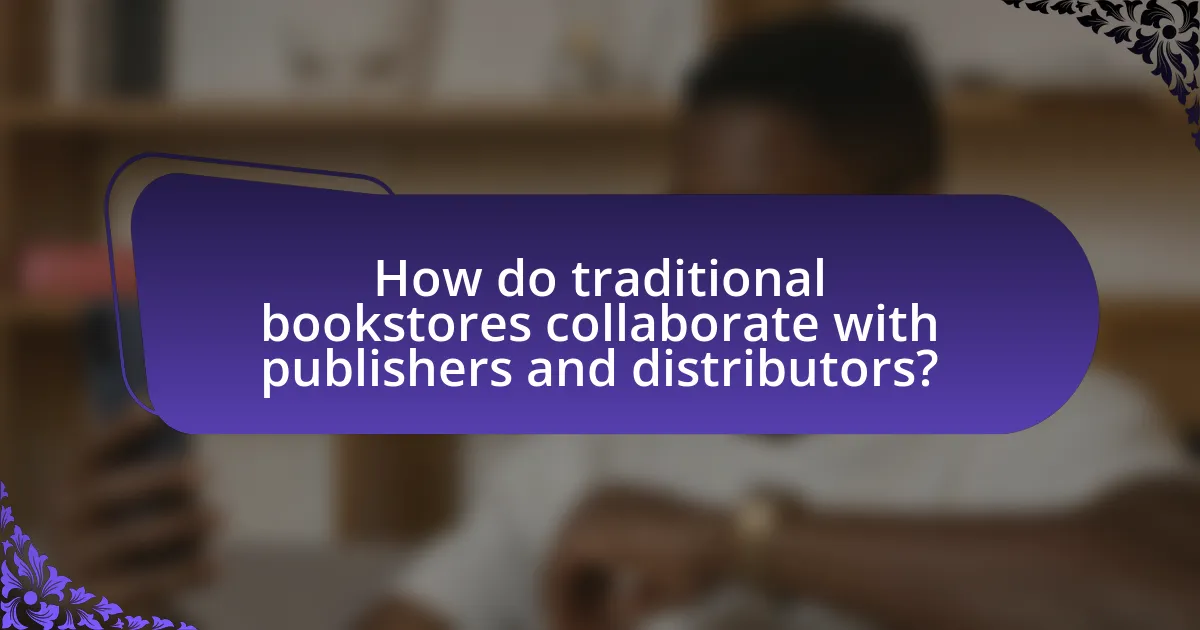
How do traditional bookstores collaborate with publishers and distributors?
Traditional bookstores collaborate with publishers and distributors through various mechanisms such as purchasing agreements, promotional events, and inventory management. Bookstores typically establish relationships with publishers to acquire books at wholesale prices, allowing them to sell at retail prices while maintaining a profit margin. Additionally, bookstores often participate in promotional events, such as book signings and readings, which are organized in collaboration with publishers to boost sales and visibility for new releases. Furthermore, effective inventory management systems are employed by bookstores to ensure they stock popular titles and manage returns, which is facilitated by communication with distributors who provide insights on market trends and consumer preferences. This collaboration is essential for maintaining a diverse selection of titles and ensuring that bookstores remain competitive in the evolving retail landscape.
What are the benefits of partnerships between traditional bookstores and publishers?
Partnerships between traditional bookstores and publishers enhance market reach and sales efficiency. These collaborations allow publishers to leverage the physical presence of bookstores, which can attract customers who prefer in-person shopping experiences. Additionally, bookstores benefit from exclusive access to new titles and promotional support from publishers, which can drive foot traffic and increase sales. According to a 2021 survey by the American Booksellers Association, 70% of independent bookstores reported that partnerships with publishers significantly boosted their sales of new releases. This symbiotic relationship fosters a stronger literary community and supports local economies by promoting reading and cultural engagement.
How do traditional bookstores influence book selection and promotion?
Traditional bookstores significantly influence book selection and promotion by curating titles based on customer preferences and market trends. These bookstores often employ knowledgeable staff who recommend books, creating a personalized shopping experience that can drive sales for specific titles. Additionally, traditional bookstores frequently host author events, book signings, and readings, which promote selected books and enhance community engagement. Research indicates that 70% of consumers prefer to buy books from local bookstores due to the personalized service and community connection they provide, reinforcing the impact of these stores on book promotion and selection.
What distribution models are most effective for traditional bookstores?
The most effective distribution models for traditional bookstores include direct sales, consignment, and online integration. Direct sales allow bookstores to maintain control over inventory and customer relationships, while consignment enables them to offer a wider selection without upfront costs, as they only pay for books sold. Online integration, such as e-commerce platforms, expands reach and caters to changing consumer preferences, with studies indicating that 30% of consumers prefer purchasing books online. These models collectively enhance profitability and customer engagement for traditional bookstores.
What best practices can traditional bookstores implement for modern distribution?
Traditional bookstores can implement best practices for modern distribution by adopting an omnichannel approach that integrates online and offline sales. This strategy allows bookstores to reach a broader audience by offering e-commerce options alongside in-store experiences, catering to consumer preferences for convenience and accessibility.
For instance, a study by the American Booksellers Association found that independent bookstores that embraced online sales saw a 30% increase in revenue, demonstrating the effectiveness of this approach. Additionally, utilizing data analytics to understand customer preferences can enhance inventory management and personalized marketing efforts, further optimizing distribution channels.
By leveraging partnerships with local authors and publishers, traditional bookstores can also create unique offerings that differentiate them from larger retailers, fostering community engagement and loyalty. These practices collectively position traditional bookstores to thrive in a competitive distribution landscape.
How can traditional bookstores enhance customer loyalty through distribution strategies?
Traditional bookstores can enhance customer loyalty through targeted distribution strategies by offering personalized services and exclusive access to products. By implementing a local delivery service, bookstores can cater to customers’ preferences for convenience, which has been shown to increase repeat purchases. For instance, a study by the American Booksellers Association found that independent bookstores that provide home delivery options see a 30% increase in customer retention. Additionally, creating partnerships with local authors for exclusive book signings or events can foster a sense of community and belonging, further solidifying customer loyalty. These strategies not only improve customer satisfaction but also differentiate traditional bookstores from online competitors, reinforcing their value in the market.
What innovative marketing techniques can traditional bookstores use to attract customers?
Traditional bookstores can attract customers by implementing experiential marketing techniques, such as hosting author events, book clubs, and themed reading nights. These activities create a community atmosphere that encourages customer engagement and loyalty. For instance, a study by the American Booksellers Association found that independent bookstores that host events see a significant increase in foot traffic and sales, with 70% of customers attending events making a purchase. Additionally, leveraging social media for targeted promotions and collaborations with local businesses can enhance visibility and attract diverse customer segments.

